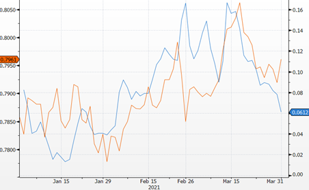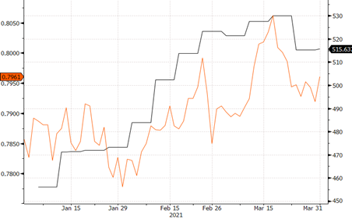
Beware The Right Tail
6 April 2021
Wasn’t the dollar supposed to weaken in 2021?
20 April 2021INSIGHT • 13 April 2021
Loonie in the Spotlight

Ali Jaffari, Head of North American Capital Markets
What is driving the CAD?
In the first quarter of 2021, the USD was one of the best performing currencies and strengthened against a majority of G10 nations, proving its resilience in a reflationary environment where global bond prices are on the decline and traditional haven currencies lose traction. Across major currency baskets, only two currencies outperformed the big dollar: GBP and CAD. The Canadian Dollar was the biggest gainer in 1Q-2021, despite ongoing fallouts from the pandemic including increased lockdown measures and continued delays in the vaccination program.
The bulk of CAD gains materialized intra-quarter, with bullish moves seen across major CAD crosses. In recent weeks, however, CAD momentum subsided to some degree and traded sideways. Let’s take a look at some of the key factors that contributed to CAD strength in Q1:
Much like the rest of the global sovereign bond market, Canadian yields have been on the rise
At the longer end of the curve, 10Y Government of Canada yields rose by ~90bps in the quarter outpacing the rise in US 10Y Treasuries (~80bps increase over the same time period). The surge in Canadian yields is partly driven by U.S. policy support and inflationary pressures, which in turn benefit Canadian markets. Front end CA-US rate differentials (i.e. 2Y spreads), a strong depicter of currency moves, widened and favored CAD strength vs the USD (see Chart 1).
Chart 1: CA-US 2Y Yield Spread (blue) vs CAD/USD (orange)

Source: Bloomberg
2. As the reflation theme dominates markets, commodity prices trade unilaterally higher
Commodity markets continue to rally, supported by rising global demand as nations start to emerge from pandemic related closures. China’s strong economic recovery is partly contributing to increased commodity flows, specifically on the energy front. Crude oil prices (Canada’s main export) are up ~25% (increased as high as ~35%) for the quarter providing a further boost to CAD. The Bank of Canada (BoC) looks at a price index of 26 commodities produced locally and sold in world markets – the total basket is up ~15% YTD and has correlated strongly to CAD (see Chart 2).
Chart 2: Bank of Canada Commodity Price Index (black) vs CAD/USD (orange)

Source: Bloomberg
3. Increased foreign capital flows into Canadian equity markets
Over the past decade, the S&P 500 has outperformed the Toronto Stock Exchange (TSX) in nine out of ten years, to the tune of ~200% (difference of cumulative total return). Low interest rates and ongoing monetary and fiscal stimulus measures continue to boost equity markets, with the TSX up 8% in the quarter (vs 6% for the S&P 500).
Canadian equity markets are picking up traction for a number of reasons:
- Accelerated M&A activity, especially within the technology sector. Private equity deal closures were up significantly in 2020 (despite low deal activity in 2020 H1) and a similar trend is expected to ensue in 2021 as U.S PE funds and strategic buyers accumulate dry powder for capital deployment.
- The commodities ‘super cycle’ is attracting foreign capital to Canadian resource equities. Higher carbon reduction measures are also benefitting Canadian energy producers by supporting the local oil industry’s ESG measures.
- Despite other nations paring back on immigration advancement, Canada’s policies remain open and favorable as it continues to attract world-class talent, increasing the flow of human and financial capital.
4. Economic data is positive and continues to beat market expectations
Recent Canadian data releases have shown signs of improvement for the overall economy. Employment figures for the month of March jumped by +303K (vs consensus estimate of +100K), as job creation was driven by all classes of workers.
The unemployment rate reduced from 8.2% to 7.5% but remains well away from the pre-pandemic level of 5.7%. Economic momentum was also shown by a pickup in GDP growth (0.7% in Jan), beating consensus and easing fears of an outright economic downturn. Year on year inflation growth however remains just above the 1% level, well below the BoC’s target 2% level.
The above driving forces have no doubt fueled Canadian dollar strength, however whether it could propel further momentum remains to be seen. There are several mitigant factors to be considered in the near-term that could hamper recent CAD appreciation.
- As provinces reintroduce lockdown measures and restrictions to curb the spread of the third wave, near-term economic performance will take a hit. Job losses are likely to occur as several businesses remain closed and the initial expected surge from consumer spending is delayed.
- The ascent in oil prices, which was a big boost to CAD has since tempered from growing concerns on the global demand outlook for crude, as several importing nations are met with a resurgence in COVID-19 case counts and face further restrictive measures. In addition, OPEC+ will look to partially roll back its supply cuts over the next 3 months, limiting upward moves in oil in the near-term.
- There is a growing divergence with other nations, specifically the U.S., which is far ahead when it comes to fiscal stimulus, vaccination program and re-opening measures – ~34% of the U.S. population have received at least one dose of the vaccine, which is almost double that of Canada (just under 18%). The economic performance gap will only widen in the near-term as Canada further delays its re-opening measures.
The BoC acknowledged the strong economic activity at its meeting in March and highlighted the bright prospects for Canadian exports and business investment in light of improving foreign demand. As a result, the market is pricing in a tapering of its quantitative easing program (at its April meeting), and a reduction in bond purchases from $4 billion to $3 billion per week.
Uncertainty remains on the Bank’s forward guidance on its policy rate – given the firm economic backdrop and strong data, it could make for a good case for the Bank to pull forward its rate hike expectations, but recent restrictions resulting in continued economic slack could mean otherwise.
Canada has lagged its peer nations on the vaccine roll-out plan. Ongoing delays and restrictions will no doubt place near-term pressure on the Canadian dollar, as investors shift their focus to economies that are farther along in the recovery cycle. Barring additional supply disruptions – Canada expects two million vaccine doses this week and continued supply from Pfizer of 1 million doses per week until the end of May (thereafter ramping up to 2 million per week). This ramp up, along with lifting of restrictions could lead to a resumption in the upward trajectory of the Canadian dollar as we head into the peak summer months, moving closer to achieving critical mass.
Be the first to know
Subscribe to our newsletter to receive exclusive Validus Insights and industry updates.


